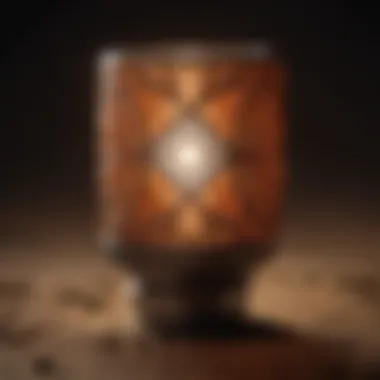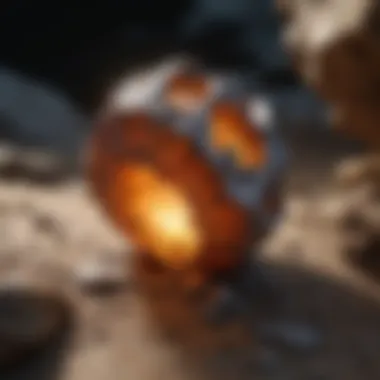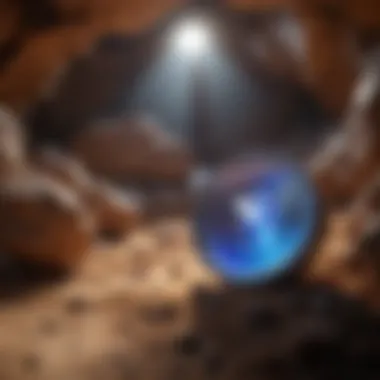Unveiling the Top Shortwave UV Flashlight for Rock and Fossil Enthusiasts


Rock and Fossil Identification
Rock and fossil identification is a crucial skill for enthusiasts in the field of geology. When using shortwave UV flashlights, different types of rocks and fossils can exhibit unique fluorescence patterns, aiding in their identification. Understanding the characteristics to look for in rocks and fossils is essential. For instance, certain minerals may fluoresce brightly under UV light, distinguishing them from others. Additionally, having the right tools for identification, such as UV protective goggles and a reliable UV flashlight, is paramount to accurately discerning the composition of specimens.
Collecting Tips and Techniques
To optimize your rock and fossil collecting experience, adhering to best practices is fundamental. When exploring prime collecting sites, research geological maps and seek areas with high mineral content for a greater chance of finding unique specimens. Implementing safety measures while extracting specimens, such as wearing protective gear and using appropriate tools like chisels and brushes, is essential to prevent damage to both yourself and the specimens.
Preservation and Display
Preserving rocks and fossils can ensure their longevity and quality for future observation. Techniques such as cleaning specimens with gentle brushes and tools, avoiding harsh chemicals that may damage them, and storing them in a temperature-controlled environment can prevent degradation over time. Proper storage methods like using acid-free paper and containers can further safeguard the integrity of your collection. When it comes to display, consider creative ideas like shadow boxes, acrylic stands, or themed arrangements to present your rocks and fossils attractively.
Geological Insights
Delving into geological formations and processes allows collectors to appreciate the history and significance of rocks and fossils. Understanding the geological context in which specimens are found provides insights into the environmental conditions that existed millions of years ago. Rocks and fossils hold historical significance, with each telling a unique story about Earth's past. Exploring notable discoveries in the field of geology can inspire collectors to expand their knowledge and appreciation for the wonders of the natural world.
Introduction
In the realm of rock and fossil collecting, the utilization of shortwave UV flashlights holds a pivotal role in illuminating the hidden world of geological wonders. This article sets out to explore the multifaceted importance of incorporating shortwave UV lighting into the collection process. By shedding light on this technology, rock and fossil enthusiasts can delve deeper into the fascinating intricacies of their specimens. The introduction will serve as a gateway to understanding how shortwave UV flashlights are instrumental in unveiling the unique characteristics and qualities of rocks and fossils that may go unnoticed under regular lighting conditions.
As rock and fossil collectors embark on their journey to uncover hidden treasures, the introduction aims to underscore the significance of shortwave UV light in enhancing the identification and appreciation of these geological marvels. By providing a comprehensive overview of the role that UV light plays in revealing fluorescence in minerals and fossils, readers will gain a newfound appreciation for the transformative power of this specialized lighting. Furthermore, the introduction will delve into the core benefits and considerations associated with utilizing shortwave UV flashlights, ranging from improving mineral identification accuracy to facilitating the detection of fluorescence patterns in fossils.
Through a careful examination of the distinct advantages that shortwave UV technology brings to the forefront, this article will guide rock and fossil collectors towards a deeper understanding of how incorporating UV lighting can elevate their collecting experiences to new heights. By offering insights into the applications, benefits, and considerations of shortwave UV flashlights, this introduction sets the stage for a detailed exploration of how this innovative tool can unlock the mysteries concealed within rocks and fossils, enabling collectors to embark on a journey of discovery like never before.
Understanding Shortwave UV Light


What is Shortwave UV Light?
Shortwave UV light is a type of ultraviolet radiation with wavelengths between 100 and 280 nanometers. Unlike visible light that we see every day, UV light is invisible to the naked eye. Shortwave UV light carries higher energy levels compared to longer wavelength UV light, allowing it to induce fluorescence in certain minerals and fossils. By emitting these short wavelengths, UV light can reveal the unique characteristics and compositions of rocks and fossils that are otherwise unseen.
Significance in Rock and Fossil Collecting
Shortwave UV light plays a pivotal role in rock and fossil collecting for several reasons. One key significance lies in its ability to unveil fluorescence in minerals and fossils that contain specific elements. When exposed to shortwave UV light, certain minerals and fossils fluoresce, emitting light in various colors and patterns. This fluorescence not only enhances the aesthetic appeal of specimens but also aids in their identification and differentiation. Rock and fossil collectors rely on shortwave UV light to distinguish between different mineral compositions and detect hidden features that may go unnoticed under normal lighting conditions. Understanding the significance of shortwave UV light is essential for collectors to fully appreciate and evaluate their geological finds.
Key Features of the Best Shortwave UV Flashlight
Shortwave UV flashlights play a crucial role in the world of rock and fossil collecting, offering enthusiasts a unique tool to enhance their collecting experience. When considering the best shortwave UV flashlight, there are several key features that one must take into account to ensure optimal performance and usability.
Wavelength
UV flashlights emit light in different wavelengths, with shortwave UV falling within the 100-280 nm range. This specific wavelength is ideal for activating fluorescence in minerals and fossils, allowing collectors to easily identify unique characteristics that are not visible under normal light conditions. The ability to tune into this specific wavelength is a fundamental feature that distinguishes shortwave UV flashlights for rock and fossil enthusiasts.
Intensity and Output
The intensity of a shortwave UV flashlight refers to the strength of the emitted UV light. Higher intensity UV flashlights are more effective in illuminating fluorescent materials, providing collectors with clearer and more vibrant displays of fluorescence. Additionally, output power is crucial as it determines the coverage area and brightness of the UV light, impacting the visibility of fluorescent responses in rocks and fossils.
Durability and Construction
Durability is a key aspect to consider when selecting the best shortwave UV flashlight. Since collectors often venture into rugged terrains, their UV flashlight must be robust enough to withstand outdoor conditions. Look for flashlights constructed with high-quality materials such as aluminum or reinforced plastics to ensure longevity. Additionally, ergonomic design considerations such as grip comfort and water resistance can enhance the overall user experience, making it easier for collectors to navigate through their specimens with ease.
Choosing the Right Shortwave UV Flashlight


In the realm of rock and fossil collecting, selecting the appropriate Shortwave UV Flashlight is paramount to enhancing the overall experience and efficiency of identifying unique geological specimens. The process of Choosing the Right Shortwave UV Flashlight involves delving into specific elements that can greatly impact the effectiveness of the tool. Key considerations include factors such as wavelength accuracy, intensity levels, and overall durability to withstand rugged field conditions while ensuring precise illumination for rock and fossil examinations.
Researching Brands and Models
When embarking on the journey to find the ideal Shortwave UV Flashlight, intensive research into various brands and models is critical. Different manufacturers offer a range of features and specifications, each catering to different user preferences and needs. By meticulously reviewing reviews, specifications, and user feedback, collectors can gain valuable insights into the performance, reliability, and reputation of different brands and models. This thorough investigation helps in narrowing down the options and selecting the most suitable Shortwave UV Flashlight according to individual requirements.
Budget Considerations
The aspect of budget plays a significant role in the process of Choosing the Right Shortwave UV Flashlight. Collectors should establish a clear budget range based on their financial constraints and investment capacities. While higher-priced models may offer advanced features and superior build quality, there are also budget-friendly options available that provide adequate UV lighting capabilities without compromising on essential functionalities. By assessing the cost-efficiency and long-term value of each model, collectors can make an informed decision that aligns with both their financial means and performance expectations.
Portability and Ergonomics
Another crucial factor to consider when selecting a Shortwave UV Flashlight is its portability and ergonomic design. Rock and fossil collectors often venture into various terrains and environments during their expeditions, requiring a portable and user-friendly flashlight that is easy to carry and handle. An ergonomic design ensures comfortable grip and usability, minimizing fatigue during prolonged use. Additionally, compact and lightweight models enhance maneuverability and convenience in fieldwork, allowing collectors to navigate with ease while effectively illuminating specimens for examination. Ensuring the flashlight's portability and ergonomics meet the demands of outdoor exploration is essential for a seamless and efficient collecting experience.
Applications of Shortwave UV Flashlights in Collecting
Shortwave UV flashlights play a crucial role in the realm of rock and fossil collecting, offering enthusiasts a unique perspective that traditional lighting sources cannot provide. One of the key applications of shortwave UV flashlights is mineral identification. By emitting light in a specific wavelength range, these flashlights allow collectors to distinguish between different minerals based on their fluorescence properties. This ability is invaluable when examining rock specimens with hidden fluorescent features, as it can reveal patterns and colors that are invisible to the naked eye.
Moreover, shortwave UV flashlights are instrumental in fluorescence detection in fossils. Fossils often contain traces of minerals or organic matter that fluoresce under ultraviolet light, unveiling intricate details and textures that enhance the overall aesthetic value of the specimens. By utilizing shortwave UV flashlights, collectors can uncover the hidden beauty of fossils and gain a deeper appreciation for the geological processes that shaped them.
Maintenance and Care Tips for UV Flashlights
In the realm of rock and fossil collecting, the maintenance and care of UV flashlights play a crucial role in ensuring optimal performance and longevity of these essential tools. Rock and fossil collectors heavily rely on UV lighting to uncover hidden fluorescence in minerals and fossils, making the proper upkeep of UV flashlights paramount to their success in identifying and examining specimens. By implementing effective maintenance and care practices, collectors can prolong the lifespan of their UV flashlights and maximize their utility in the field.
When considering maintenance and care tips for UV flashlights, one must pay close attention to several key elements. It's imperative to regularly inspect the flashlight for any signs of wear and tear, such as cracks in the lens or housing, and promptly address any issues to prevent further damage. Additionally, cleaning the UV flashlight after each use using gentle cleaning solutions and a soft cloth helps maintain the clarity of the lens and ensures optimal light output. Proper storage in a protective case or pouch not only shields the flashlight from external elements but also prevents accidental damage during transportation.


Moreover, collectors should conduct periodic checks on the battery compartment to ensure proper functioning. By examining the contacts for corrosion and replacing batteries as needed, enthusiasts can avoid disruptions during critical expeditions. Careful battery management, including the removal of batteries when the flashlight is not in use for an extended period, helps prevent leakage and preserves the overall integrity of the device.
Overall, incorporating regular maintenance and care routines into the handling of UV flashlights is fundamental for enthusiasts in the field of rock and fossil collecting. By adhering to these essential tips, collectors can safeguard their investment, optimize the performance of their UV flashlight, and enhance their overall collecting experience.
Cleaning Procedures
Cleaning procedures for UV flashlights are integral to ensuring their functionality and longevity in rock and fossil collecting endeavors. Following each use, it is advisable to gently wipe down the exterior of the flashlight with a damp cloth to remove dirt, dust, and debris that may have accumulated during exploration. Care should be taken to avoid using harsh chemicals or solvents that could potentially damage the housing or lens of the flashlight.
For more thorough cleaning, collectors can disassemble the flashlight according to the manufacturer's instructions to access hard-to-reach areas for a more comprehensive cleaning. Removing any residue or build-up from the lens and reflector helps maintain the efficiency of UV light transmission and ensures consistent performance in fluorescence detection. Once cleaned, the flashlight should be thoroughly dried before reassembling to prevent moisture damage and corrosion of internal components.
By incorporating regular cleaning procedures into their maintenance routine, rock and fossil collectors can preserve the quality and effectiveness of their UV flashlights, enabling continued success in mineral identification and fluorescence detection during fieldwork.
Battery Management
Proper battery management is key to reliable performance and extended lifespan of UV flashlights used in rock and fossil collecting. Rock and fossil enthusiasts should adhere to best practices for battery maintenance to avoid unexpected failures during critical moments in their expeditions. Regular inspection of the battery compartment for any signs of corrosion or leakage is crucial in preventing damage to the flashlight and ensuring uninterrupted usage.
When replacing batteries, it is essential to use high-quality, compatible batteries recommended by the flashlight manufacturer. Mixing different battery types or using expired batteries can compromise the performance of the UV flashlight and potentially lead to malfunctions. Enthusiasts are advised to recharge rechargeable batteries fully before extended use and avoid completely discharging them to maintain optimal battery health.
Furthermore, proper disposal of old or damaged batteries in accordance with environmental regulations is essential to safeguard the environment and prevent contamination. By adopting responsible battery management practices, rock and fossil collectors can prolong the lifespan of their UV flashlights, reduce environmental impact, and maintain consistent performance during their collecting activities.
Conclusion
In the realm of rock and fossil collecting, the utilization of shortwave UV flashlights emerges as an indispensable tool for enthusiasts seeking to delve deeper into the world of geological specimens. Throughout this comprehensive guide on exploring the best shortwave UV flashlight, key insights have been highlighted to emphasize the vital role that UV lighting plays in enhancing the identification and appreciation of unique rock formations and fossils.
One significant aspect addressed in this article is the unparalleled ability of shortwave UV light to reveal hidden fluorescence patterns present in minerals and fossils. This revelation not only adds an element of intrigue to the collecting experience but also aids collectors in distinguishing between different types of specimens based on their fluorescence properties. By shedding light on these intricate details that are often invisible to the naked eye, shortwave UV flashlights open up a new dimension of exploration and discovery for rock and fossil enthusiasts.
Moreover, the discussion on the key features to consider when selecting the best shortwave UV flashlight delves into the importance of factors such as wavelength, intensity, output, durability, and construction. By understanding the significance of these features and their impact on the effectiveness of UV light in illuminating specimens, collectors are equipped with the knowledge needed to make informed decisions on their flashlight purchase. This serves to enhance the overall collecting experience and ensures that enthusiasts are able to maximize the utility of their UV flashlight in the field.
Furthermore, as the applications of shortwave UV flashlights in mineral identification and fluorescence detection in fossils continue to evolve, the conclusions drawn from this article emphasize the continuous relevance of UV lighting in advancing the field of rock and fossil collecting. By staying abreast of the latest developments in UV flashlight technology and its applications, collectors can remain at the forefront of discovery and appreciation for the diverse geological wonders that nature has to offer.
In essence, the significance of the conclusion in this article lies in its ability to encapsulate the importance of shortwave UV flashlights in revolutionizing the way rock and fossil collectors engage with their hobby. By integrating UV lighting into their collecting routine, enthusiasts can unlock a world of hidden fluorescence, vibrant colors, and unique mineral compositions, enhancing their exploration of geological treasures and fostering a deeper connection with the natural world.







